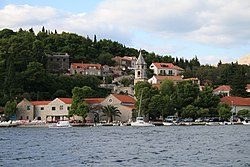| Cavtat | |
|---|---|
| Village | |
 View of Cavtat View of Cavtat | |
 | |
| Coordinates: 42°34′N 18°13′E / 42.567°N 18.217°E / 42.567; 18.217 | |
| Country | Croatia |
| County | Dubrovnik-Neretva County |
| Municipality | Konavle |
| Area | |
| • Total | 5.8 km (2.2 sq mi) |
| Elevation | 1 m (3 ft) |
| Population | |
| • Total | 2,189 |
| • Density | 380/km (980/sq mi) |
| Time zone | UTC+1 (CET) |
| • Summer (DST) | UTC+2 (CEST) |
| Postal code | HR-20 210 |
| Area code | +385 20 |
| Licence plate | DU |
Cavtat (Croatian pronunciation: [t͡sǎʋtat], Italian: Ragusa Vecchia, lit. 'Old Ragusa') is a village in the Dubrovnik-Neretva County of Croatia. It is on the Adriatic Sea coast 15 kilometres (9 miles) south of Dubrovnik and is the centre and the main settlement of Konavle municipality.
History
Antiquity
Main article: EpidaurumThe original city was founded by the Greeks settlers from Corinth in the 6th century BC under the name of Epidaurus (or Epidauros, Greek: Ἐπίδαυρος). The surrounding area was inhabited by the Illyrians, who called the city Zaptal.
The town changed its name to Epidaurum when it came under Roman rule in 228 BC. Justinian I the Emperor of the Byzantine Empire sent his fleet to Cavtat during the Gothic War (535–554) and occupied the town.

The city was sacked and destroyed by the Avars and Slavs in the 7th century. Refugees from Epidaurum fled to the nearby island, Laus (Ragusa) which over time evolved into the city of Dubrovnik.
Middle Ages
The town was re-established in the Middle Ages (Italian: Ragusa Vecchia). After a short while it came under the control of its powerful neighbor, the Republic of Ragusa.
The modern Croatian name for the city reveals its ancient origins and its link with Dubrovnik. Cavtat is derived from Civitas Vetus, which means old city in Latin Language.
Economy
Today, Cavtat is a popular tourist destination with many hotels and private households that rent rooms and apartments. The seafront is filled with shops and restaurants. There are several beaches in Cavtat and its surroundings, among them Pasjača, as well as Ključice, Obod, Rat and Žal. A ferry boat connects the town to neighbouring Mlini and Dubrovnik. There are often many private luxury ships and yachts along the strand.
It was named most popular honeymoon destination in Europe for 2023 by European Best Destinations.
Culture

The town cemetery on the hill contains a mausoleum belonging to the Račić family and decorated by the sculptor Ivan Meštrović.
In year 2004 Cavtat got the title European Competition for Towns and Villages in Blooms, especially for the well-tended green areas and flower arrangements on the beach promenade.
The Epidaurus Festival of Music has been held annually in Cavtat since 2007.
Notable people

- Vlaho Bukovac (1855–1922), painter
- Tino Pattiera (1890–1966), opera singer
- Luko Zore (1846–1906), philologist and Slavist
- Frano Supilo (1870–1917), politician
- Baltazar Bogišić (1834–1908), jurist, law historian and ethnologist
- Niko Koprivica (1889–1944), politician
- Dinko Zlatarić (1558–1613), poet and translator
- Raimondo Cunich (1719–1794), humanist
- Ljudevit Vuličević (1839–1916), Serbian writer and patriot
International relations
See also: List of twin towns and sister cities in CroatiaTwin towns — Sister cities
Cavtat is twinned with:
See also
Gallery
-
View from the harbour
-
St Nicholas church
-
Shore at Cavtat
-
Harbour
-
Monastery of Our Lady of the Snow
-
Town hall
-
 The Hotel Croatia
The Hotel Croatia
-
 Fresh local cuisine
Fresh local cuisine
References
- Notes
- Register of spatial units of the State Geodetic Administration of the Republic of Croatia. Wikidata Q119585703.
- "Population by Age and Sex, by Settlements" (xlsx). Census of Population, Households and Dwellings in 2021. Zagreb: Croatian Bureau of Statistics. 2022.
- "Cavtat pronunciation: How to pronounce Cavtat in Croatian (Hrvatski)". Retrieved 2009-09-18.
- "List of settlements in Dubrovnik-Neretva County". narodne-novine.nn.hr. 2006-07-28. Retrieved 2019-04-17.
- Cabanes, Pierre (2008). "Greek Colonisation in the Adriatic". In Tsetskhladze, Gocha R. (ed.). Greek Colonisation: An Account of Greek Colonies and Other Settlements Overseas. Vol. 2. Brill. p. 271. ISBN 9789047442448.
- Aulus Hirtius, De Bello Alexandrino XIV
- Austria: Her People & Their Homelands by James Baker,""... dates back to the sixth century BC., when the Greeks founded here Epidaurus"
- Dictionary of Greek and Roman Geography: Abacaenum-Hytanis. 1854 by Sir William Smith
- Ostrogoths were at war with Byzantine Empire in the 6th century.
- Researches on the Danube and the Adriatic by Andrew Archibald Paton (1861). Contributions to the Modern History of Hungary and Transylvania, Dalmatia and Croatia, Servia and Bulgaria- page 247
- Dalmatia and Montenegro by Sir John Gardner Wilkinson
- Notizie Istorico-Critiche Sulla Antichita, Storia, e Letteratura de' Ragusei (published in two vols) by Francesco Maria Appendini.
- The Biographical Dictionary of the Society for the Diffusion of Useful Knowledge Volume 3, Part 1. 1843. Great Britain
- "Best honeymoon destinations in Europe". European Best Destinations. Retrieved 11 June 2023.
- Bronze plaque on the promenade, photographed in June 2017.
- "Cavtat - 2012". Epidaurus festival. 2012-06-15. Retrieved 2013-03-26.
- "Watsonville forms ties with Croatian city". Register-Pajaronian. Retrieved 2018-09-20.
External links
- Cavtat Info, Villa Vidak: Cavtat Information
- Cavtatportal.com, Up to date news from Cavtat and vicinity
42°34′46″N 18°13′15″E / 42.57944°N 18.22083°E / 42.57944; 18.22083
| Settlements of Konavle | |
|---|---|